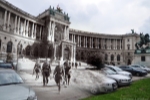
考研英语作文常用句子总结【一】
第三次课: 分词在句子中的用法
教学目标: 使学生初步了解及在句子使用分词
教学内容:
一、 动名词及不定式作业讲解
二、分词
现在分词和过去分词两种。
作为谓语,现在分词和be 一起构成进行时;过去分词和be一起构成被动语态,和have一起构成完成时。
例如:
I am reading a novel by Maupassant. 我正在看一本莫泊桑写的小说。(现在分词和be 一起表示主语正在进行的动作。)
Mr. Robinson has drunk five glasses of wine already. 鲁宾逊先生已经喝了五杯酒了。(过去分词和have 一起表示主语已经完成的动作。)
The gold fish bowl was broken by Xiao Tao just now. 金鱼缸刚才被小陶打破了。(过去分词和be 一起表示主语是动作的承受者。)
作为非谓语形式,分词可用作形容词和副词,在句子中充当定语、表语、补语和状语。但它仍保持动词的一般特征,可以有自己的宾语和状语。分词和自己的宾语、状语构成分词短语。 现在分词有一般式和完成式。它的一般式表示和谓语动词所表示的动作同时发生的行为或存在的状态;它的完成式(having + 过去分词)表示在谓语动词所表示的动作之前发生的动作或存在的状态。
现在分词有主动语态和被动语态(being + 过去分词。
过去分词只有一般式,表示在谓语动词所表示的动作之前发生的动作。过去分词(及物动词)本身可以表示被动的含义,因而没有别的被动形式。
例如:
Having failed three times, he didn’t want to try again. (=As he had failed three times, he didn’t want to try again. 他失败了三次,不想再干了。(having failed 表示发生在前的动作)
Walking along the sands, Crusoe saw in the sand the mark of a man’s foot. (=While he was walking along the sands, Crusoe? 克鲁索沿着沙滩走的时候,看见沙上有人的脚印。(walking 表示同时发生的动作)
The question being discussed seems important. (=The question is being discussed. It seems important. 正在讨论的问题似乎很重要。
The old days are gone. 旧时代一去不复返了。(gone 表示完成的状态)
I had my hair cut yesterday. 我昨天理发了。(cut 是及物动词的过去分词,表示“被人理发”。) 分词的否定形式是在分词短语前面加上not, never等否定词构成。
例如:
Not fearing the fire, the child touched and got a finger burnt. 小孩儿不知道怕火,用手去摸,把手指烫了。
Not knowing how to find the subway, I asked a policeman for help. 我不知道怎样找到地铁,就去找警察帮忙。
(一)现在分词和过去分词的区别
(1)在语态上现在分词表示主动的意思,表示它所修饰的人或物的行为;及物动词的过去分词表示被动的意思,表示它所修饰的人或物是动作的承受者。换言之,现在分词是它修饰
的成分所作出的动作,过去分词是它修饰的成分所承受的动作。
例如:
convincing facts 有说服力的事实 / convinced audience 被说服了的听众
the exploiting class 剥削阶级 / the exploited class被剥削阶级
a frightening dog一条让人害怕的狗 / a frightened dog一条被吓坏了的狗
driving gears主动齿轮 / driven gears从动齿轮
(2)在时间上,现在分词往往表示动作正在进行,过去分词表示动作已完成。
例如:
the rising sun (正在升起的太阳 / the risen sun(升起的太阳)
the falling rain(正在下的雨)/ the fallen leaves(落下的树叶)
stolen money(被盗的钱/偷来的钱)/ill-gotten wealth(不义之财)
a high-flying kite(高飞的风筝)
再看一些例子:
boiling water 沸腾的水/boiled water 开水/developing countries 发展中国家/developed countries 发达国家/an exciting story 令人激动的故事/ excited people 激动的人们
(2)在时间上,现在分词往往表示动作正在进行,过去分词表示动作已完成。
再看一些例子:
surprising news令人惊讶的消息/a surprised man受惊吓的人/an inspiring leader具有号召力的领袖/the inspired soldiers受到鼓舞的士兵/a delighted speech令人高兴的演说/the delighted audience(感到高兴的听众/a moving film动人的电影/the moved children受到感到的孩子们/a box containing tea装茶叶的盒子/the tea contained in a box装在盒里的茶叶/ falling snow正在下的雪/fallen snow box落在地上的雪
(3)做表语时的不同。现在分词做表语表示主语所具有的特征,意思是“令人如何”。过去分词多表示主语所处的状态,意思是“感到如何”。
例如:
His lecture is disappointing。I’m disappointed。他的演讲令人失望。我感到失望。
We are surprised to hear the news。The news is surprising。我们听到那消息吃了一惊。那消息令人吃惊。
The situation is encouraging。 We’re encouraged。形式使人鼓舞。我们感到鼓舞。
常用的还有:amusing/amused,astonishing/astonished,disappointing/disappointed,exciting/excited,frightening/frightened,interesting interested,moving/moved, relaxing/relaxed,satisfying/satisfied,shocking/shocked,surprising/surprised,terrifying/terrified,tiring/tired,worrying/worried等等。
(4)做状语的区别,分词短语在句中可做时间、原因、方式、伴随状语。现在分词的动作和谓语动作同时或几乎同时发生、意思是主动的。而过去分词的动作在谓语动作之前发生、意思是被动的。
例如:
Seeing nobody at home,she decided to leave them a note。看到没人在家,她决定给他们留个条。(主动意义,几乎同时
The secretary worked late into the night,preparing a speech for the president。秘书工作到晚上很晚,给总统准备一篇演说。(主动意义,同时
Tired of the noise,he closed the window。对噪音感到厌烦,所以他把窗户关上。(被动意义,
在谓语之前
Deeply moved,she thanked me again and again。她深深地受了感动,再三谢我。(被动意义,在谓语之前
Persuade by my mother,she gladly went there alone。在我母亲劝说下,她才高兴地独自去那里。(被动意义,在谓语之前
如果现在分词的动作在谓语动作之前发生,现在分词要用完成形式,但意思仍然是主动的。 例如:
Having watered the vegetables,they began to pick up the Apples。=After they had watered the vegetables,they began to pick up the apples。他们浇完了蔬菜之后就开始摘苹果。 Having finished the work,he packed his tools and left。完工后,他收拾起工具走了。 分词做状语时,前面可用连词或介词。
例如:
After eating my dinner quickly,I went to see Jim off。我赶快吃过晚饭就去给吉姆送行。 Though built before the Second World War,the engine is still in good condition。尽管是在二战以前建的,这引擎仍然处于良好状态。
Unless paying by credit card,please pay in cash。如果不用信用卡付款,请用现金付。 Tom will never do this unless compelled。汤姆永远也不会干这种事,除非被逼无奈。 She’s been quite different since coming back from America。从美国回来后,她大变了。
(二)用法
1.作定语。作定语的分词通常放在被修饰的名词之前。如果被修饰的词是something,anything,everything,nothing等,则分词放在这些词之后。分词短语通常放在被修饰的名词之后。
例如:
This is an interesting book。(=This is a book。It is interesting。这是一本有趣的书。
There is something interesting in the news。(=There is something in the news。 It is interesting。消息中有些有趣的事。
The man sitting by the window is our math teacher。(=The man who is sitting by the window is our math teacher。靠窗户坐着的那个人是我们的数学老师
The machine run by the old worker is made in Shanghai。(=The machine that is run by the old worker is made in Shanghai。那位老工人开的机器是上海造的。
Most of students singing were girls。(=Most of the students who were singing?唱歌的学生多数是女生。
Many of the villagers questioned refused to answer。(=Many of the villagers who were questioned?被问的许多村里人都拒绝。
注意:(1)分词作定语与动名词作定语的区别:
分词和它所修饰的名词有逻辑上的主、谓关系。动名词则没有这种关系,而表示它所修饰的词的用途或有关动作。
现在分词 动名词
A sleeping child(a child who is sleeping正在睡觉的孩子 A sleeping car(a car for sleeping卧车
A flying bird(a bird that is flying飞鸟 A flying course(a course for flying飞行课程
A swimming girl(a girl who is swimming游泳的女孩 A swimming pool(a pool for swimming游泳池
The running water(the water that is running流水 The running track(the track for running跑道 现在分词和它所修饰的名词都要重读,动名词所修饰的名词则不必重读。
(2)现在分词作定语时,它表示动作正在进行或与谓语动词所表示的动作同时发生(或差不多同时发生。
例如:
Who is the boy dancing over there?在那儿跳舞的少年是谁呀?
The girls swimming in the sea were in danger。 在海里游泳的姑娘们有危险。
如果两个动作在时间上有先后,一般不能用现在分词作定语,而往往用主从复合句结构。 例如:
The man who has gone to Shanghai will be back again。到上海去的那个人会回来的。
The teacher wants to talk to the students who smashed the windows。老师要找打破了窗子的那个学生谈话。
(3)be的现在分词being不能用作定语(可用作状语或被动语态中的助动词。表示这种概念时,也用主从复合句结构。
例如:
He has a brother who is a worker。他有一个当工人的兄弟。
2、作状语。分词和分词短语作状语时,可以表示时间、原因、行为方式等意义。表示时间和原因的分词短语相当于对应的状语从句。
例如:
Seeing the teacher entering the room,the students stood up。(=When the students saw the teacher entering the room,They stood up。学生们看见老师走进房间,都站了起来。 (时间
Heated,the Metal expands。 (=The metal expands if /when it is heated。金属受热而膨胀。(条件、时间
Being excited,I couldn’t go to sleep。(=As I was excited ,I couldn’t go to sleep。我兴奋得睡不着觉。(原因
Being a student,he was interested in sports。(=As he was a student,he was interested in sports。 他是个学生,所以对体育运动感兴趣。(原因
Inspired by Dr.Yang’s speech,Li Hua and his classmates decided to study physics harder。(=As they were inspired by Dr.Yang’s speech,Li Hua and his classmates decided to study physics harder。李华和他的同学们受到杨博士讲话的鼓舞,决定更加努力学习物理。 (原因 The children went away laughing。=The children went away。They laughed as they went。孩子们笑着走开了。(行为方式
The professor stood there,surrounded by many students。(=The professor stood there。He was surrounded by many students。教授站在那里,许多学生围着他。(行为方式
While reading the newspaper,father nodded from time to time。(=While he was reading the newspaper,father nodded from time to time。看报时,父亲不时地点头。(时间(分词前,可加表示时间的连词while或when。
3、作宾语补足语。
例如:
Can you get the machine going again?你能使机器再动起来吗?
You should have your hair cut。你该理发了。
I saw him coming last night。我昨天晚上看见他来了。
4、作表语。
例如:
The film is very moving。这部影片很感人。
Your homework is well done。你的作业做得好。
The visitors looked surprised.参观者看上去很惊讶。
The boys were seen walking on the grass。有人看见孩子们在草地上散步。
5、作句子独立成分(分词有自己的逻辑主语时,称为独立主格结构。)
例如:
Flags flying,the army men marched in the streets。旗帜飘扬,军队在街上行进。
All his ribs broken,he lay half dead。他的肋骨全部折断,半死不活地躺着。
分词(短语作状语时,其逻辑主语必须与句子的主语一致。如果不一致,必须用独立主格结构来表示,也就是在分词前面加上它的逻辑主语。
My wife had a long talk with Sally, explaining why she didn’t want the children to play together我妻子与莎莉谈了很长时间,解释她为什么不想让孩子们在一起玩。(现在分词explaining是句子主语my wife做的动作,它们之间是主动关系
Given more attention,the trees could have grown better。如果对这些树多关心一些,它们本来会长得更好。(过去分词given表示的动作是句子主语the trees承受的动作,它们之间是被动关系
We explored the caves,Peter acting as guide。我们到那山洞探险,彼得做向导。 (独立主格 The train having gone,we had to wait another day。分词短语做状语时,前面可以加上连词或介词,但是分词短语和句子之间不能用并列连词(如but,and,因为并列连词接的是两个并列成分,而分词短语只是全句的一个状语部分。分词和主句之间可用逗号。
例如:
误:Having been told many times,but he still couldn’t understand it。
正:He was told many times, but he still couldn’t understand it。
注意:(1)分词作状语时,逻辑主语即句子的主语;否则要用从句或独立主格结构来表示。 例如:
Looking out of the window,I saw lots of people there。(=When I looked out of the window,I saw lots of people there。
我往窗外一看,看见那儿有许多人。 (looking out of the window的逻辑主语,就是句子的主语I。
(2)在see,hear,watch,notice等动词后,用动词不定式作宾语补语,通常表示(强调动作从开始到结束的全过程。如果用现在分词作宾语补语,则通常表示动作正在进行。 例如:
We sat two hours and watched the teacher make the experiment。我们坐了两个小时,看老师做实验。(两小时一直在看老师做实验
We passed by the classroom and saw the teacher making the experiment。我们走过教室,看见老师在做实验。(只是在走过教宰的一刹那间,看见老师正存做实验
I saw him enter the room, unlock a drawer, take out a document, photograph it and put it back。我看见他走进房间,打开抽屉,拿出一份文件,拍了照又放回去(表示一个接一个的一系列动作的全过程时,用动词不定式。
考研英语作文常用句子总结【二】
1. Nancy is too young to dress herself.
Nancy is not _____ _____ to dress herself.
2. My watch doesn't work well.
There is ____ _____ _______ my watch.
3. Jane doesn't go to work by bus any longer.
Jane ____ _____ _____ to work by bus.
4. It took Mary two weeks to prepare for the exam.
Mary _____two weeks____ ______ for the exam.
5. It seems that they have known each other.
They seem to _____ _____ each other.
6. "My grandpa doesn't like coffee or coke" said Bob
Bob said that _____grandpa liked _____coffee _____coke.
7. Cao Fei joined the League three years ago.
Cao Fei _____ ____ _____ the League for three years.
8. I prefer walking there to going by bus.
I prefer to walk there ____ _____ going by bus.
9. -Thank you very much. -You're welcome.
- ____ a lot. -Not at____ .
10. Kitty does well in English.
Kitty ____ ____ ____ English.
11. They realized Hainan was a beautiful place after they reached there.
They____ realize Hainan was a beautiful place_____ they reached there.
12. We will have to finish the work hardly if you don't help us. We can't finish the work _____ _____ ______
13. My dictionary isn't so thick as yours.
My dictionary is _____ than yours.
14. Could you tell me where the East Street Hospital is? Excuse me, ____ is the _____ to the East Street Hospital?
15. The book is exciting to read.
It is ____ _____ read the book.
16. Jack's mother asked him, "Have you packed your things?" Jack's mother asked him ____ he ____ packed his things.
17. She likes singing better than dancing. She ____ singing ____ dancing.
18. Remember to ring me up as soon as you get to Nanjing Make ____ to give me a ring as soon as you _____ Nanjing.
19. They couldn't catch the train because of the heavy traffic. The heital?
15. The book is exciting to read.
It is ____ _____ read the book.
16. Jack's mother asked him, "Have you packed your things?" Jack's mother asked him ____ he ____ packed his things.
17. She likes singing better than dancing. She ____ singing ____ dancing.
18. Remember to ring me up as soon as you get to Nanjing Make ____ to give me a ring as soon as you _____ Nanjing.
19. They couldn't catch the train because of the heavy traffic. The heavy traffic _____ them from _____ the train.
20. My brother has been away from home for two days.
My brother _____ home two days _____ .
21. Li Lei decided to move to Canada when he was thirty.
Li Lei made a _____ to move to Canada at the _____ of thirty.
22. Jim was too careless to pass the exam last term.
Jim was not_____ _____ to pass the exam last term.
23. If you don't hurry up, you can't catch the train.
Hurry up, _____ you may _____ the train.
24. Yang Li wei said to us, "I'm going to visit your school tomorrow. " We were all pleased.
We were all pleased when we heard Yang Li wei_____ visit_____ school the next day.
25. This is the most interesting film I have ever seen. I have ____seen _____ an interesting film before.
26. I was late for school because of the traffic accident. The traffic accident _____ me _____ getting to school on time.
考研英语作文常用句子总结【三】
1) Many nations have been faced with the problem of ……
2) Recently the problem has been brought into focus.
3) Recently the phenomenon has become a heated topic.
4) Recently the issue has aroused great concern among ……
5) Nowadays there is a growing concern over ……
6) Never in our history has the idea that …… been so popular.
7) Faced with ……, quite a few people argue that ……
8) According to a recent survey, ……
9) With the rapid development of ……,
10 When it comes to…, (当说到…
二、列举观点
I.Some people think/believe that…,
Other argue/claim that the opposite/reverse is true
1.Obviously television has both advantages and disadvantages.
2.Living in a city has both advantages and disadvantages.
3.Compared with cars,bikes have their advantages and disadvantages. ,
4.Although computers bring people a lot of convenience,they have many disadvantages.
5....has many advantages.For example,…
6. However,just as every coin has two sides,…has it’s disadvantages.
II…play(san important role/part in……
1.Computers play an important role in science and technology.
2.Computers play a more and more important role in our life.
3.Computers play an increasingly important role in our studies.
4.Education plays an important part in developing our mind.
5.Addiction to alcohol and drugs plays a role in homelessness.
6.Advertisement plays an informative role in our daily life.
7.In the past,letters played a decisive role in long-distance communication.But now,telephone,email,and fax have taken their place.
III.With the development of…
1.With the development of our economy,many Chinese families can afford a car.
2.With the development of our economy and society,pollution is more and more serious.
3.With the rapid development of Science and technology,people can get a college degree by taking online-courses at home.
4.With the current social and technological developments,employees with more knowledge and higher academic degrees are needed.
5.With the rapid increase of China's population,housing problem is becoming more and more serious.
6.With more and more women entering the society,people's attitude towards women is changing.
7.With the deepening of Chinese reform and opening up, an increasing number of (a growing number of,a significant number of
families can afford a car.
三、陈述自己观点
There is probably some truth in both arguments/statements,but…
四、批驳
1)It is true that ……, but one vital point is being left out.
2) There is a grain of truth in these statements, but they ignore a more important fact.
3) Some people say ……, but it does not hold water.
4) Many of us have been under the illusion that……
5) A close examination would reveal how ridiculous the statement is.
6) It makes no sense to argue for ……
7) Too much stress placed on …… may lead to ……
8) Such a statement mainly rests on the assumption that ……
9) Contrary to what is widely accepted, I maintain that ……
10) No one can deny the fact that ……
11) The idea is hardly supported by facts.
12) Unfortunately, none of the available data shows ……
13) Recent studies indicate that ……
14) There is sufficient evidence to show that ……
15) According to statistics proved by ……, it can be seen that ……
五、结尾句型 :
英语议论文多以简要总结全文或对所讨沦的问题提出解决办法来结尾。总结全文时除常用到in one/a word,generally speaking,to conclude等外,没有固定模式。提出解决办法时却常使用下一句型:
1) From what has been discussed above, we can draw the conclusion that ……
2) It is high time that strict measures were taken to stop ……
3). We should take measures to control the rapidly increasing world population.
4). We’d better take effective measures to prevent students from cheating on exams.
5). The government decided to take strong measures against drug abuse.
6). Urgent measures should be taken to prevent terrorists from carrying out further attacks.
7) It is necessary that steps should be taken to ……
8) In conclusion, it is imperative that ……
9) There is no easy method, but ……might be of some help.
10) To solve the above-mentioned problem, we must ……
11) In summary, if we continue to ignore the above-mentioned issue, more problems will crop up.
12) With the efforts of all parts concerned, the problem will be solved thoroughly.
13) We might do more than identify the cause ; it is important to take actions to ……
14) Taking all these into account, we ……
15) Whether it is good or not /positive or negative, one thing is certain/clear……
六、其他句型
I、There be结构
There+be+主语+(修饰成分,表示客观存在的'人或事物。 There must be a lot of fuel in the tank.
There remains nothing more to be done.
There is no point in talking about it again.
There is something you don't know.
There is not enough time to do the work. .
II、名词化结构
名词化结构用以表明抽象思维的逻辑性和概念化,从而使语体更加正式、更加具有书面语风格。
1.由of连接主谓关系
That the earth revolves around the sun causes the changes of the seasons.
名词化:The revolution of the earth around the sun causes the changes of the seasons.
2.由0f连接动宾关系
One of the most important natural phenomena is that energy is transmitted from one point to another in waves.
名词化:One of the most important natural phenomena is the transmission of energy from one point to another in waves.
3.用of连接含有by的短语,把简单句转换成名词短语
考研英语作文常用句子总结【四】
It ______ ______ ______ the train will be late.
答案:is likely that
2. It is likely that the typhoon will sweep across the island.
The typhoon ______ ______ ______ ______ across the island.
答案:is likely to sweep
3. I think trying to stop the couple quarrelling will be of no use.
I think it's ______ ______ ______ to stop the couple quarrelling.
答案:no use trying
4. Every time I was in trouble, he had no hesitation in helping me.
Every time I was in trouble, he came to help me ______ ______.
答案:without hesitation
5. He never hesitates to help if I have any problem.
He always helps me ______ ______ if I have any problem.
答案:without hesitation
6. I crossed the street so as not to meet him, but he saw me and came running towards me.
I crossed the street to ______ ______ him, but he saw me and came running towards me.
答案:avoid seeing
7. It seems that the students in that class have all passed the qualified exam.
All of the students in that class ______ ______ ______ ______ the qualified exam.
答案:seem to have passed
8. It seems that the boys of the class are playing football on the playground.
The boys of the class ______ ______ ______ ______ football on the playground.
答案:seem to be playing
考研英语作文常用句子总结【五】
1。 It is considered /thought that人们(有人,大家)认为
2。 It is generally /usually accepted /agreed/recognized that普遍(一般,通常)认为
3。 It is believed that有人(人们,大家)相信
4。 It is well—known that大家知道(众所周知)
5。 It is said that据说(有人说)
6。 It is learned that据闻(悉)
7。 It is supposed that据推测
8。 It is estimated/predicted/calculated that据估计(预计)
9。 It must be pointed that必须指出
10。 It is reported that据报道
11。 It must be admitted that必须承认
12。 It will be seen that可见(可以看出)
13。 It will be seen from this that由此可见
14。 It is understood that不用说(都知道)
15。 It can not be denied that无可否认
16。 It has been proved/demonstrated that已经证明
17。 It may be confirmed that可以肯定
18。 It may be safely said that可以有把握地说
19。 It is sometimes asked that人们有时会问
20。 It is expected that/hoped that人们希望
21。 When it comes to要说到,要谈及
考研英语作文常用句子总结【六】
1.参观时间: 五月四日,星期三
2.颐和园简介: 它是中国最大的保存最完好的皇家园林, 风景优美, 甚是迷人, 有山有水, 有皇家建筑和画廊。
3.活动安排: 上午自由参观, 中午在快餐馆吃午饭, 下午5:30返回宾馆。
4.集合时间: 星期三早上6:10, 汽车6:30开, 行驶45分钟。
5.集合地点: 宾馆大门口。
要求: 不要逐条翻译, 词数100词左右 。
One possible version:
May I have your attention?
可以让我注意吗?
We will visit the summer Palace on Wednesday, May 4. The Summer Palace is the largest well-kept royal park in China. In the park there is water and man-piled hills. There are some royal buildings and a gallery, too. I am sure you will be struck by its beautiful scenery. In the morning we will be free to visit the different places of the Palace and then we will have lunch in the fast-food restaurant. We will get back to the hotel at half five. Please gather at the hotel gate at 6:10 on Wednesday morning. The buses will start at 6:30. It will take us about 45 minutes to get there. Please be on time. Thank you.
我们将于星期三参观颐和园,五月四日。颐和园是中国最大的皇家公园。在公园里有水和人堆山。还有一些皇家建筑和一个画廊。我相信你会被它美丽的风景所打动。在上午我们将自由访问不同的地方的宫殿,然后我们将在快餐店吃午饭。我们将回到酒店的一半五。请聚集在酒店门口6:10星期三早上。公共汽车将在6:30。到那儿要花45分钟的时间。请准时。谢谢你。
















